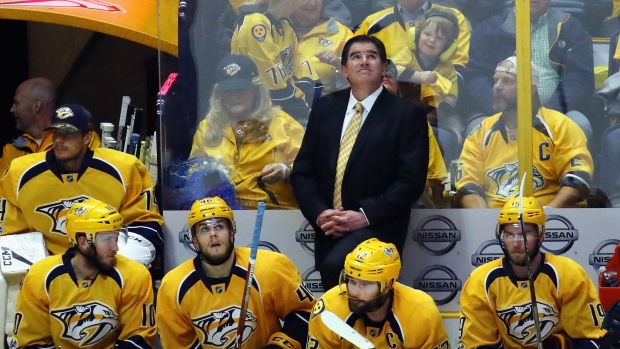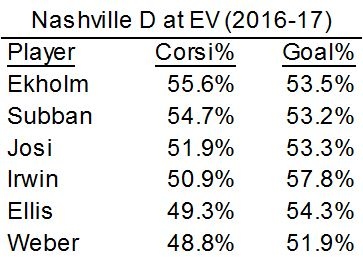May 29, 2017
How Laviolette deploys his deep, talented defence
Nashville coach trusts his top-four defencemen to play in all situations against varying levels of difficulty, Travis Yost writes.
By Travis Yost

One of the curious arguments I’ve seen floated during the rise of the Nashville Predators is that their success, at least in part, is driven by the fact that they have assembled two equitable first pairings on defence. It is further posited that this has allowed for head coach Peter Laviolette to shelter the P.K. Subban and Mattias Ekholm duo by burdening Roman Josi and Ryan Ellis with tougher duty.
It’s absolutely true that Nashville’s blueline is deep and talented. Any coach who has Subban/Ekholm and Josi/Ellis playing the lion’s share of minutes is going to be in a position to succeed, and Matt Irwin-Yannick Weber are as strong a third pairing as any in the National Hockey League.
Laviolette seems to have recognized this early on. For example, Nashville’s top four generally play the same amount of minutes at even strength. During the regular season, Ekholm, Subban, and Josi played almost identical minutes (about 18 per game), with Ellis playing about a minute less. So it is absolutely fair to say that Nashville has two pairings who see an equal amount of ice.
The data, however, doesn’t seem to support anything beyond that. Let’s talk about the sheltering argument for a minute. If this were true, then we would expect to see the likes of Josi/Ellis seeing significantly more talented forwards over the course of the regular season, with Subban/Ekholm – in equivalent minutes – playing more against second and third-line guys.
But look at the makeup of the forwards each of these defenders has faced. I’ve grouped their opposition ice time into two categories – the average “rank” of the opposing forward they faced in a given season (in which one would indicate the most utilized forward for an opposing team; 12 would indicate the least utilized forward for an opposing team), and the percentage of minutes each defender saw against a team’s “top line.”
And, just in case you were curious, I’ve also included how frequently they were starting shifts in the defensive zone (in which 100 per cent would indicate every shift start began with a defensive zone draw).
We already know that Laviolette played his top-two pairings roughly the same amount of minutes. Based on this data, it sure seems like he also played them against a pretty comparable level of competition. They predominantly played a mix of first and second-line forwards, and generally saw about 40 per cent of their total ice time dedicated to slowing down an opposing team’s top line. The top four also saw an equal number of tough defensive zone starts. The only notable item is that Laviolette did try and shelter his third pairing a bit – less difficult matchups, more offensive zone draws, etc.
I can’t ascertain any difference between Nashville’s top four in terms of deployment. Laviolette seems to trust both groups.
But deployment and results are two very different points of discussion. Laviolette might utilize his pairings in generally the same manner, but that doesn’t mean they are equal in performance. In fact, since we know that these pairings are virtually interchangeable, you would expect that their year-to-date performance numbers look identical.
That’s not really the case. (These numbers include both regular season and postseason.)

Subban/Ekholm spend much more time in the offensive zone than either of Nashville’s other pairings. The interesting thing is that while Corsi% is pretty disparate, Goal% is much flatter. That would certainly seem to suggest that, for whatever reason, Nashville’s non-Subban/Ekholm pairings have been relatively more reliant on their own goaltending to bail them out of trouble. That seems less like an indicator of quality defensive performance and more of a data point in support of Pekka Rinne.
In summary: Nashville’s blueline is fantastic (duh), and I think Laviolette really does trust his top four to play in all situations against varying levels of difficulty. I also think that, in light of the above, it’s hard to argue that Nashville’s best pairing isn’t Subban-Ekholm. They are burdened with the same amount of minutes, the same number of “difficult” minutes based on opposition quality, and generally come out as better performers.
Now, the million-dollar question: If Subban-Ekholm is Laviolette’s best pairing, should he play them against the Crosby line or the Malkin line? Ottawa threw their best pairing against the Crosby line in the Eastern Conference final and were one goal away from knocking off the defending Stanley Cup champions. It’ll be interesting to see if Laviolette follows a similar line of thought, or if he looks to give that pairing more opportunity against Pittsburgh’s lesser lines.

